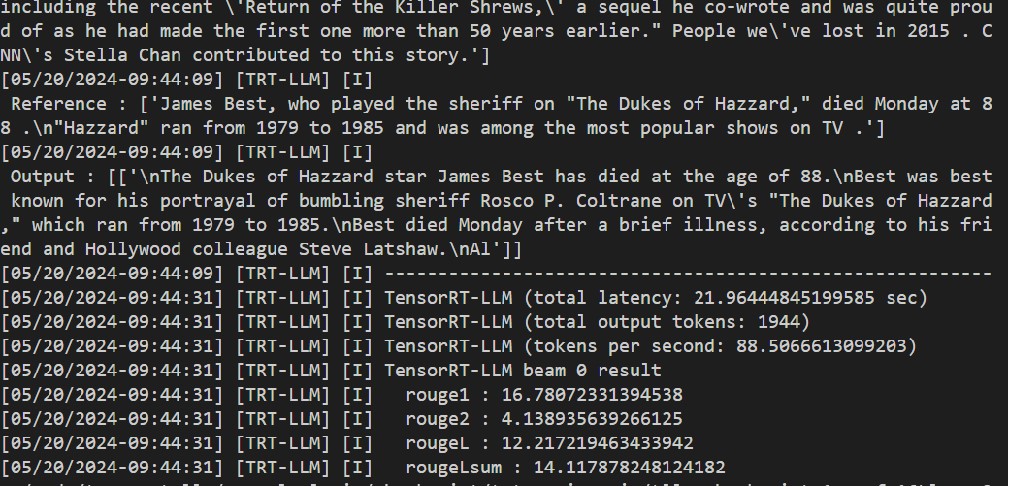MIXQ: Taming Dynamic Outliers in Mixed-Precision Quantization by Online Prediction
It is very easy to quantize a LLM and run by MIXQ 4bit or 8bit kernel
Running the following CMD to quantize the LLM with W8A8O16 kernel:
python examples/basic_quant_mix.py --model_path /mnt/data/checkpoint/Llama-2-7b --quant_file /home/dataset/quant/quant8/Llama-2-7b --w_bit 8
Benchmark the throughput of MIXQ by:
python benchflops.py --model_type mix --model_path /home/dataset/quant/quant8/Llama-2-7b --quant_file /home/dataset/quant/quant8/Llama-2-7b --batch_size 512 --bit 8
In NVIDIA A100-PCIE-40GB, the output is
Version: mix 8bit
| Batch Size | Decode Length | Decode tokens/s | Memory (VRAM) |
|-------------:|----------------:|------------------:|:-----------------|
| 512 | 1024 | 10609.8 | 7.86 GB (19.97%) |
We have integrate the MixedQLinear designed by QUIK into our framework! The QUIK now is able to support a wide range of LLMs including:
- Llama-2 7B/13B/70B
- Llama-3 8B
- Falcon 7B/40B
- ChatGLM 7B
- QWen2 7B
It is very easy to quantize a LLM and run by QUIK 4bit kernel
Running the following CMD to quantize the LLM
python examples/basic_quant_quik.py --model_path /mnt/data/checkpoint/Llama-2-7b --quant_file /home/dataset/quant/quantquik4/Llama-2-7b --w_bit 4
Benchmark the throughput of QUIK by:
python benchflops.py --model_type quik --model_path /home/dataset/quant/quantquik4/Llama-2-7b \
--quant_file /home/dataset/quant/quantquik4/quik4/Llama-2-7b \
--batch_size 512 --bit 4
In NVIDIA A100-PCIE-40GB, the output is
Version: quik 4bit
| Batch Size | Decode Length | Decode tokens/s | Memory (VRAM) |
|-------------:|----------------:|------------------:|:-----------------|
| 512 | 1024 | 8981.17 | 4.88 GB (12.40%) |
We have supported the end-to-end text generation in TRT-LLM and VLLM!
For TRT-LLM, please download the NVIDIA TensorRT docker. TensorRT docker. DO NOT USE your local environment!
Please enter the e2eTRTLLM folder:
cd e2eTRTLLM
Please Running the docker:
docker run --rm -it --ipc=host -v /home/code/:/code/tensorrt_llm \
-v /home/dataset/checkpoint:/dataset -v /home/checkpoint:/code/checkpoint \
--ulimit memlock=-1 --ulimit stack=67108864 \
--gpus=all --env "CCACHE_DIR=/code/tensorrt_llm/cpp/.ccache" \
--env "CCACHE_BASEDIR=/code/tensorrt_llm"
After starting the docker, set the env :
model=Llama-2-7b
ngpu=1
export model_dir=/code/tensorrt_llm/checkpoint/${model}
export quant_dir=/code/tensorrt_llm/checkpoint/checkpoinmix/tllm_checkpoint_${ngpu}gpu_fp16${model}
export out_dir=/code/tensorrt_llm/checkpoint/trt_enginesmix/tllm_checkpoint_${ngpu}gpu_fp16${model}
Please quantize the model by:
CUDA_VISIBLE_DEVICES=0 python quantize.py --model_dir ${model_dir} \
--output_dir ${quant_dir} --dtype float16 --device cpu \
--qformat int8_mix --calib_size 32
Please build the MIXQ model by:
CUDA_VISIBLE_DEVICES=0 trtllm-build --checkpoint_dir ${quant_dir} \
--output_dir ${out_dir} \
--gemm_plugin float16 --mix_precision int8
Generating the text with MIXQ by:
CUDA_VISIBLE_DEVICES=0 python summarize.py --test_trt_llm \
--hf_model_dir ${model_dir} \
--data_type fp16 \
--engine_dir ${out_dir}
model=Llama-2-70b
ngpu=4
export model_dir=/code/tensorrt_llm/checkpoint/${model}
export quant_dir=/code/tensorrt_llm/checkpoint/checkpoinmix/tllm_checkpoint_${ngpu}gpu_fp16${model}
export out_dir=/code/tensorrt_llm/checkpoint/trt_enginesmix/tllm_checkpoint_${ngpu}gpu_fp16${model}
Please quantize the model by:
CUDA_VISIBLE_DEVICES=0,1,2,3 python quantize.py --model_dir ${model_dir} \
--output_dir ${quant_dir} --dtype float16 --device cpu \
--qformat int8_mix --calib_size 32 --pp_size ${gpu}
Please build the MIXQ model by:
CUDA_VISIBLE_DEVICES=0,1,2,3 trtllm-build --checkpoint_dir ${quant_dir} \
--output_dir ${out_dir} \
--gemm_plugin float16 --mix_precision int8
Generating the text with MIXQ by:
CUDA_VISIBLE_DEVICES=0,1,2,3 mpirun -np 4 --allow-run-as-root python summarize.py --test_trt_llm \
--hf_model_dir ${model_dir} \
--data_type fp16 \
--engine_dir ${out_dir}
When running the summarize.py of MIXQ (Llama-2-7B in A100, 40GB, PCIE), we get:
